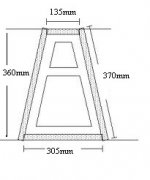how to determined acoustic offset
1. set the mic @80cm @tw axis
2. set your volume/pre around 75-85db reading from your tweeter I don't have SPL meter
3. dont change the above, keep the mic at the same place, keep the volume at same position throughout the measurements.
4. measure your tweeter how?
5. measure your midwoofer how?
6. connect the T and M parallel and measure the MT response. in box?
now, im not familiar with other xover simulation, i have been using jeff b's Passive Crossover Designer 7 with great success, it needs MS Excel 2007.
in PCD7, load the Woofer and Tweeter FRD, then import the MT measurements with the import overlay option just under the FR plot.
set the listening distance 0.8 on PCD, then input your physical vertical offset, if your midwoofer is below your tweeter with distance about 14cm, then put 0.14 as the units in meter.
play the Z-offset (Acoustic Offset) until you can match the summed MT frd with the overlay combined FRD.
typical Z-offset of 4-6" midwoofer to a dome tweeter is about 0.019-0.027.
2. reading from your mic to ur measurements software, either REW, HolmImpulse or Omnimic.
4. use your mic
5. same as 4
6. if you have 4 binding post, just jumper it + to + and - to -, then both drivers will play together.
4. use your mic
5. same as 4
6. if you have 4 binding post, just jumper it + to + and - to -, then both drivers will play together.
if you want, send me your FRD and tell me more about your speakers:
1. Baffle Size
2. CTC between woofer and tweeter.
To measure impedance, DATS is very useful or you can use REW with your soundcard, you have to read the manuals though as i dont use REW.
1. Baffle Size
2. CTC between woofer and tweeter.
To measure impedance, DATS is very useful or you can use REW with your soundcard, you have to read the manuals though as i dont use REW.
I don't have DAT to measure the impedance, I use Holm to measure the drivers frecuency response. What's FRD: frecuency response?
I can't attach the tweeter in box without filter zip because is 1Mb and diyA forum can support. Can I send you an email?
Last edited:
Are you sure your email si right?
This is an automatically generated Delivery Status Notification.
Delivery to the following recipients failed.
This is an automatically generated Delivery Status Notification.
Delivery to the following recipients failed.
Last edited:
thats my address, please edit it, as spam can use it. whats ur email, ill email to u then u cab reply back
Received your email, what when answered still same Delivery Status Notification as recipient failed😕
Felipe, let me try this again.
First, it still looks like the measurement of your tweeter is not quite right yet. Graphs below:
1. Seas measurement
2. Zaph's measurement
3. your cabinet's baffle effects with the chamfer using BDS (note the very magnified scale)
4. what your measurement should more or less look like when 2 and 3 are combined
5. what your measurement actually look like
So you're showing a 5dB rise at 7k and about a 10dB rise at about 15k that probably shouldn't be there.
Secondly, besides Troels design with the 18W8545-00 that you already posted (attachment 6), Vance Dickason did a design with the 18W8545K0 (attachment 7) which although slightly different, has a very similar FR to the 18W8545-00. Each takes a different but equally valid approach to the the xo. Troels uses a combination of a smaller inductor (1.2mH) with an LCR contour filter that squashes the remaining peak at about 800-1000Hz to bring the SPL level down to about 84/85dB. Dickason elects not to use the contour filter and therefore uses a much larger inductor value (3mH) to bring the level at 800-1000Hz down to about 82/83dB to compensate a little more for baffle step loss.
Because you are trying to put a xo together with the limited number of parts that you already have, I am suggesting that you follow Dickason's approach here - I don't think you will have the values necessary to implement Troels' LCR contour filter as well as the rest of the xo.
So 1 more time, using PCD and your measurement of the 18W8545 on your baffle but spliced to a vented response below 300Hz with 6dB baffle step loss and graph 4's simulated response of your tweeter, attachment 8 is the xo that I previously suggested as a good starting point for you. Put it together and see how it sounds. The last graph shows the summed response. Place the speaker where you will have it normally playing and turn it up to normal listening levels. Run it in mono. If there is too much bass, we need to lower the inductor value to 2.7mH; if there is too much we need to raise it. Tweeter resistance may need to be tweaked as well. Measure it too and we can can all work on it but listen with your ears not just the microphone.
First, it still looks like the measurement of your tweeter is not quite right yet. Graphs below:
1. Seas measurement
2. Zaph's measurement
3. your cabinet's baffle effects with the chamfer using BDS (note the very magnified scale)
4. what your measurement should more or less look like when 2 and 3 are combined
5. what your measurement actually look like
So you're showing a 5dB rise at 7k and about a 10dB rise at about 15k that probably shouldn't be there.
Secondly, besides Troels design with the 18W8545-00 that you already posted (attachment 6), Vance Dickason did a design with the 18W8545K0 (attachment 7) which although slightly different, has a very similar FR to the 18W8545-00. Each takes a different but equally valid approach to the the xo. Troels uses a combination of a smaller inductor (1.2mH) with an LCR contour filter that squashes the remaining peak at about 800-1000Hz to bring the SPL level down to about 84/85dB. Dickason elects not to use the contour filter and therefore uses a much larger inductor value (3mH) to bring the level at 800-1000Hz down to about 82/83dB to compensate a little more for baffle step loss.
Because you are trying to put a xo together with the limited number of parts that you already have, I am suggesting that you follow Dickason's approach here - I don't think you will have the values necessary to implement Troels' LCR contour filter as well as the rest of the xo.
So 1 more time, using PCD and your measurement of the 18W8545 on your baffle but spliced to a vented response below 300Hz with 6dB baffle step loss and graph 4's simulated response of your tweeter, attachment 8 is the xo that I previously suggested as a good starting point for you. Put it together and see how it sounds. The last graph shows the summed response. Place the speaker where you will have it normally playing and turn it up to normal listening levels. Run it in mono. If there is too much bass, we need to lower the inductor value to 2.7mH; if there is too much we need to raise it. Tweeter resistance may need to be tweaked as well. Measure it too and we can can all work on it but listen with your ears not just the microphone.
Attachments
-
 seas FR.GIF47.8 KB · Views: 119
seas FR.GIF47.8 KB · Views: 119 -
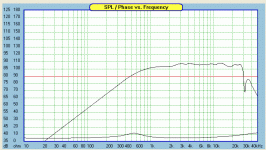 Zaph FR.GIF76.4 KB · Views: 112
Zaph FR.GIF76.4 KB · Views: 112 -
 BDS.GIF55.8 KB · Views: 100
BDS.GIF55.8 KB · Views: 100 -
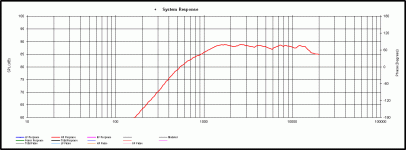 combined FR.gif19.4 KB · Views: 101
combined FR.gif19.4 KB · Views: 101 -
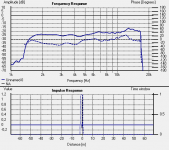 tweeter without xover.png16.7 KB · Views: 98
tweeter without xover.png16.7 KB · Views: 98 -
 18W-8545-00+9500_parallel_V2_final (1).png29.5 KB · Views: 74
18W-8545-00+9500_parallel_V2_final (1).png29.5 KB · Views: 74 -
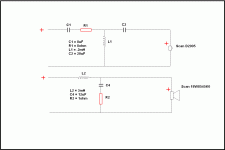 Dickason's Scan Monitor.GIF12 KB · Views: 72
Dickason's Scan Monitor.GIF12 KB · Views: 72 -
 m&m 2-way xo schematic.GIF15.1 KB · Views: 70
m&m 2-way xo schematic.GIF15.1 KB · Views: 70 -
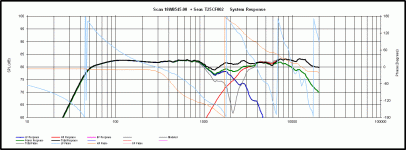 PCD FR 2-way xo.gif36.2 KB · Views: 72
PCD FR 2-way xo.gif36.2 KB · Views: 72
- Status
- Not open for further replies.
- Home
- Loudspeakers
- Multi-Way
- Help for 3 or 4 way loudspeaker
